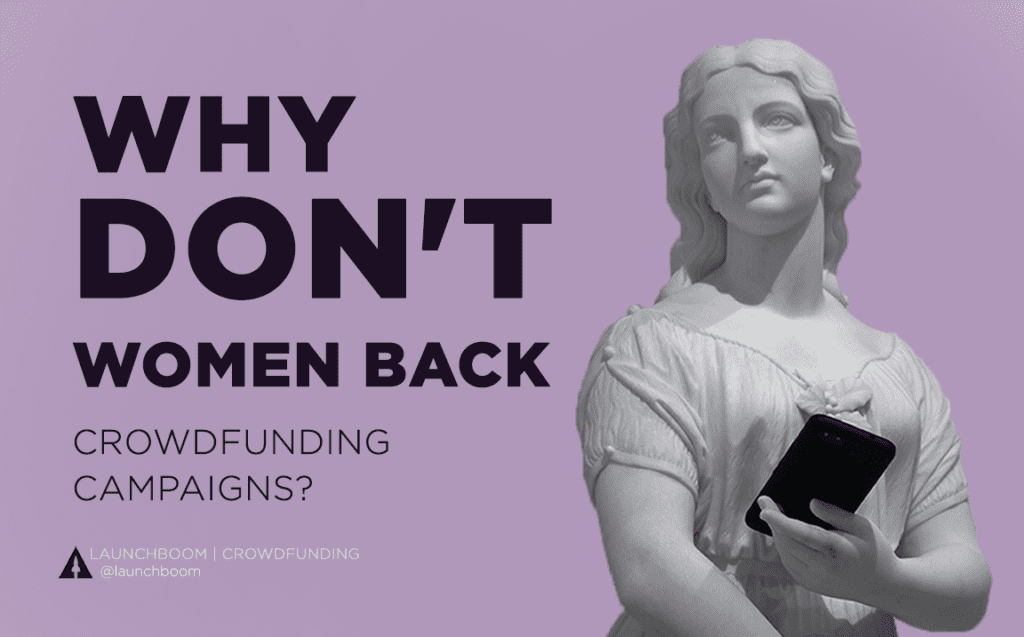
In 2020, women were expected to control $43 trillion of global consumer spending. Yes, you read that correctly—trillion with a T—and that number is going to increase as more women enter the global workforce. According to the Pew Research Center, 1 in 5 Americans have backed a crowdfunding campaign; that is 20% of the population. Other research from Inside Philanthropy shows that women donate more online than men do, especially for a philanthropic cause. With these facts evident and publicly available, why is it that women are not as likely to back crowdfunding campaigns? This is especially surprising when, statistically speaking, crowdfunding campaigns led by women are more likely to achieve their funding goal and women-led campaigns have a 5% higher pledge total than campaigns led by men.
This leads me to ask the question: How can campaign creators attract more female backers for their campaigns? Is it fair to simply fall back on the convenient and lazy thinking that women are not the risk-takers that men are, or is there more to it? After speaking with those that have launched campaigns for female-centered products, I’d say that there is more to it.
How to reach potential female backers
Real estate agents live by a singular mantra… location, location, location! When it comes to launching a female-centered product, there seems to be a parallel singular theme… messaging, messaging, messaging! The campaign and the story have to speak to women. Creators need to develop as many methods to message their product as possible, test that messaging for resonance, and then drive that message home.
“Messaging” is often a blanket term thrown out by creators, but it has multiple definitions. In the context of crowdfunding, it’s the demonstration or communication of the value or problem-solving a product/service offers to different audiences. Crowdfunding campaigns and the products they launch frequently have multiple successful methods of messaging and positioning. That is why testing is pivotal not only before the campaign launches, but once the campaign is live as well. Creators that are targeting more diverse backers must have the messaging component of the campaign clear and precise for their audiences and it must encompass a handful of critical elements.
Messaging
When it comes to messaging for female-centered products and attracting female backers, messaging needs to be inclusive. Female consumers are not in search of exclusivity; they are more attracted to and are often in search of inclusive messaging for the products and experiences they purchase. The communication must speak to more than just the individual; it needs to connect the value of the product/service with how it will impact and improve a greater good.
Remember, crowdfunding is all about pre-orders. As the creator, you’re asking someone to spend money and then wait 90 days or more to receive a product (that they may or may not receive). Female backers want to know that the risk is worth the wait. If you are a female creator, taking the time to craft, continuously test and develop, and pinpoint the best messaging is well worth it. A campaign is a living, breathing organism, and creators need to be prepared with new messaging on-hand to deploy as the original approach begins to decay and as new audiences begin to show interest in the campaign. As written above, campaigns led by women have a 5% higher pledge amount. That is significant.
Diversity
There is a question frequently asked when it comes to generating a more diverse backer audience: “Does the use of color in marketing and production influence a backer’s decision?” When it comes to female backers, the data leans toward yes. Men tend to have more tunnel vision and focus strictly on the product, and they don’t give much attention to the message or messenger. This is not always the case when it comes to women and their decision to back a campaign. The story of the creator, product, and company, how it is told, and who tells it are all important when it comes to the decision being made by a potential female backer. Diversity in the production of your advertising and marketing can have a significant influence on the decision of a female backer.
Women (unlike men) will usually consider more than just the product before making the decision to back. Using a mix of different races, body types, settings, etc. will improve storytelling to further enhance inclusivity and mitigate the perception of financial risk while instilling confidence in the female backers that a campaign is searching for. It can also curtail overthinking a decision (so-called paralysis by analysis) as well as create urgency to join the community that is backing a campaign.
Shorter fulfillment time
A third factor that will garner more female backers, according to Annette Azan (the creator of the Nuudii System, a bra alternative for women that launched a crowdfunding campaign in 2019), is a shorter fulfillment time. The Nuudii campaign raised over $930,000 and sold 16,000 units to over 13,000 backers and had a delivery date of less than 60 days. This is well below most campaigns’ delivery time, regardless of whether the product is targeting men or women. Shorter wait times will minimize the risk and ease the decision-making process for female audiences, leading to more backers. The faster you can get your product into their hands, the better.
Engage your network
A final and simple way to land more backers for a campaign launching a female-centered product is to engage the creator’s family, friends, and networks. Research tells creators that female audiences tend to support the campaigns of their family, friends, and fellow female creators. Make a concerted effort to engage your immediate friends and family about supporting your campaign. Next, make a second effort to have those friends and family encourage their personal networks to support the campaign. Expanding the awareness of a campaign to this next audience can be the accelerant for the all-important virality a successful campaign needs to take revenue from five figures to six figures or more.
What have we learned?
When launching a product, whether it is a female-centered product or not, there are a few critical points that must be prioritized to secure female backers.
- Establish a tone of inclusivity and focus on diversity when creating your advertising assets. This will help attract more diverse backers due to the broader consideration women give before backing a crowdfunding campaign.
- Take steps to keep delivery time closer to 60 days. This creates more urgency and incentive to back the campaign and reduces overthinking the purchase.
- Engage the personal network of the creator (family, friends and more) to increase the awareness of your campaign.
- Finally and most importantly, live by the mantra: messaging, messaging, and more messaging. Establish those learnings and then continue to test as the campaign progresses. If the campaign does not connect to women, then their interest and conversion is going to be minimal. It is imperative that messaging transcends the product and depicts how the campaign is achieving a greater good, not just launching a cool new product.
Want to work with a company that knows all about messaging and a whole lot more? Apply to work with us today!




